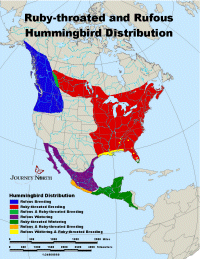| Please
Report Your Sightings! |
This week was nothing short of amazing for the rubythroat migration. Strong southerly winds and mild weather took the birds north across 13 more boundaries and into Canada! The Costa Rica farm reported this week their last hummer of the season has left. Imagine flying these distances using their little wings. Learn more about these marvelous wings and how they are adapted to allow the hummingbirds to do what other birds cannot.
Today's Report Includes:
- Highlights, Maps, and Questions
- Explore: Hummer Wing Adaptations
- Getting Started: This Week's Hummingbird Resources

Photo: Russ Thompson
Amazing wing adaptation.
(move your mouse back and forth)
Look closer...
Highlights: Summer-like Weather
This week was nothing short of amazing for the ruby-throated hummingbird migration. The strong southerly winds this week blew rubythroats into new territory. The map tells all! This past week these little gems have ridden the southerly winds to cross an additional 13 borders including the US and Canada! Along their way, observers have been ready with feeders filled. Are you keeping track on your prediction chart? One-hundred-twelve rubythroat sighting reports have come in over the week. Have you seen your first one yet? |
 |
If you live on the northern edge of the migration this week will be good for seeing your first hummer. Strong storms in the mid-continent will bring the kind of weather unsuitable for flying. Be sure to fill your feeders and keep your eyes open.
First
Alaskan Rufous Hummer Sighted
"A
male rufous hummingbird showed up briefly in the late afternoon at our
feeder -- the skies were partly sunny, but cool temperatures (43 F.).
This is one of the earliest records for the Juneau (Alaska) area -- El
Nino affect presumably?!" wrote the first observer from Auke Bay,
Alaska on 03/31/10. Since then, neighboring towns Sitka, and Edna Bay
reported their rufous hummers are back at their feeders. We know those
little birds are hardy because on April 6 it was 34°F with light snow.
In the Pacific Northwest, the rufous will most likely stay put this week due to the rain and cold weather forecast. Harlen Aschens, a hummingbird and monarch spotter in Texas tells us, "In bad weather migrating birds have to stop and can't continue inland as they normally would. This is what brings about a 'fallout'. Lots of birds but no flying until better weather arrives." Keep your feeders filled for the chance to see some of these birds.
 |
Our friends from Guayabo De Bagaes, Costa Rica reported seeing the last rubythroat for the season on their farm March 28. An observer in south Texas reported a very hungry hummer at their feeder April 1st. Could it be...the last of the rubythroats crossing the Gulf??? |
 |
"First rubythroat - looking for feeder, and I didn't have it out!!! Agh!!!!" Warm weather brought lots of sightings in new places last week. Keep the feeders up and filled to see your first hummer. Read what others shared:
 Distribution Map |
||
| Rufous
|
Ruby-throated
|
|
| Handouts:
Today's Hummingbird Map Questions Rufous Questions Rubythroat Questions |
||
Amazing
Flying Machines!
A hummingbird
can't walk or hop, but it can zip backward, forward, sideways, and upside
down. It can even hover in mid-air to sip nectar from flowers and feeders!
Few other birds can do any of these things. What's his secret?
Try
This! Hover Like a Hummer
Put your hands
out to the side, palms down, and create a "figure 8." Here's
how: Bring your hand forward and then up as you turn your palms up. Make
sure your thumbs lead the way. As your hands go back, down and around,
you'll come back to where you started. Imagine doing this 50 to 80 times
a second as you take a long drink!
- Learn more about these amazing flying machines!
|
 Photo: N.O. Smith |
The Next Hummingbird Migration Update Will Be Posted on April 14, 2010.





